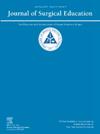Progression of Academic Surgical Residents to Higher Academic Training and Associations With Protected Characteristics: A UK Cohort Study
IF 2.1
3区 医学
Q1 EDUCATION, SCIENTIFIC DISCIPLINES
引用次数: 0
Abstract
Introduction
The Integrated Academic Training (IAT) pathway was introduced to support surgical academic careers encouraging research integration alongside clinical training. Success of the IAT pathway remains unclear. This study aims to investigate the progression of IAT surgical trainees from Academic Clinical Fellowship (ACF) to Clinical Lecturship (CL) while exploring the impact of gender, age and COVID-19.
Method and Materials
A retrospective cohort study (2016-2024) of 686 academic trainees across 10 surgical specialties was conducted using data from the Joint Committee on Surgical Training (JCST) and ISCP. Statistical analysis was performed using cox proportional hazards and logistic regression models to assess factors influencing progression from ACF to CL. Demographic variables and the impact of the COVID-19 pandemic (defined by training start year) were analysed.
Results
Progression from ACF to CL was low (7.3%) with no significant gender differences observed in progression rates (7.62% for men vs 6.32% for women). COVID-19 had a significantly negative impact on progression, with an adjusted odds ratio of 0.09 (95% CI: 0.003-0.30, p < 0.001), indicating a markedly reduced likelihood of progressing during the pandemic era. Specialty had no effect (p = 0.94), and age under 30 showed a trend toward improved progression, though not statistically significant (p = 0.316). Trainees in Paediatric Surgery and Neurosurgery had the longest academic placements.
Conclusion
The surgical IAT pathway has high attrition and unequal progression rates, especially post COVID-19. Despite gender parity in progression rates, systemic issues such as COVID-19, insufficient support and the inequalities in non-run-through training pathways hinder academic career development. Reforms are needed to address these challenges and improve the IAT pathway’s effectiveness in developing a future surgical academic workforce.
学术外科住院医师向高等学术培训的进展和与受保护特征的联系:英国队列研究
综合学术培训(IAT)途径的引入是为了支持外科学术事业,鼓励研究与临床培训相结合。IAT途径的成功尚不清楚。本研究旨在探讨IAT外科实习生从学术临床研究员(ACF)到临床讲师(CL)的进展情况,同时探讨性别、年龄和COVID-19的影响。方法与材料采用外科培训联合委员会(JCST)和ISCP的数据,对10个外科专业的686名学术学员进行了回顾性队列研究(2016-2024)。采用cox比例风险和logistic回归模型进行统计分析,评估影响ACF向CL进展的因素。分析了人口统计变量和COVID-19大流行的影响(按培训开始年份定义)。从ACF到CL的进展率很低(7.3%),在进展率方面没有明显的性别差异(男性为7.62%,女性为6.32%)。COVID-19对进展有显著的负面影响,调整后的优势比为0.09 (95% CI: 0.003-0.30, p <; 0.001),表明在大流行时期进展的可能性显著降低。专业没有影响(p = 0.94),年龄在30岁以下有改善进展的趋势,但没有统计学意义(p = 0.316)。儿科外科和神经外科的受训者的学术实习时间最长。结论手术IAT通路存在高损耗和不均匀进展率,特别是在COVID-19后。尽管在升学率方面存在性别平等,但COVID-19等系统性问题、支持不足和非全程培训途径中的不平等阻碍了学术职业发展。需要进行改革来应对这些挑战,并提高IAT途径在培养未来外科学术劳动力方面的有效性。
本文章由计算机程序翻译,如有差异,请以英文原文为准。
求助全文
约1分钟内获得全文
求助全文
来源期刊

Journal of Surgical Education
EDUCATION, SCIENTIFIC DISCIPLINES-SURGERY
CiteScore
5.60
自引率
10.30%
发文量
261
审稿时长
48 days
期刊介绍:
The Journal of Surgical Education (JSE) is dedicated to advancing the field of surgical education through original research. The journal publishes research articles in all surgical disciplines on topics relative to the education of surgical students, residents, and fellows, as well as practicing surgeons. Our readers look to JSE for timely, innovative research findings from the international surgical education community. As the official journal of the Association of Program Directors in Surgery (APDS), JSE publishes the proceedings of the annual APDS meeting held during Surgery Education Week.
 求助内容:
求助内容: 应助结果提醒方式:
应助结果提醒方式:


